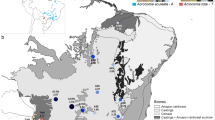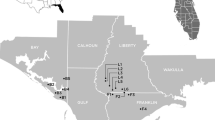Abstract
Reliable morphological identification of genetic entities within the Acacia saligna (Labill.) H.L. Wendl. species complex is difficult due to its high phenotypic plasticity, but essential due to its extensive use and ongoing development as a multipurpose agroforestry species in many countries. Acacia saligna, introduced into Ethiopia as a conservation tree in the 1980s, is recognised as a valuable multipurpose tree for fodder, fuelwood, and timber. Phenotypic variation is high, but the genetic diversity in the naturalised resource is unknown. We assessed the level of genetic diversity contained within, and genetic divergence among, five naturalised populations of A. saligna in Tigray, northern Ethiopia. Additionally, we used a Bayesian analysis approach to assign individuals of unknown taxonomic affinity in Tigrinian populations to one or more of the five known genetic entities present across the species’ natural range in Western Australia. Results suggest that naturalised populations of A. saligna established in Tigray have moderate to high levels of allelic genetic diversity, and genetic divergence among populations is low to moderate. The majority of Tigrinian individuals were assigned to the north-western lindleyi genetic entity (75.75%) or to the lindleyi genetic entity (7.57%). Knowledge of locally available genetic diversity, combined with additional genetic resources from Australia, will help researchers establish provenance resource stands that can provide a sound basis for an improvement programme. The programme will produce a range of A. saligna types for different agroforestry systems and for adoption by the farming community and forestry companies, thus supporting livelihood improvement and rehabilitation of degraded landscapes.




Similar content being viewed by others
References
Bezabih G, Godifay G, Ye-ebiyo G, Hagazi N, Estifanos A, Hagos T (2014) The value of Acacia saligna for the local beekeeping industry and the importance of bees to Acacia saligna seed yield and quality. International Conference on Acacia species for Food Security and Environmental Rehabilitation in the Dryland Areas of Northern Ethiopia,. Tigray Agricultural Research Institute, World Vision Tigray, Ethiopia
Cunningham P (2011) Trip Report. Ethiopia 14–25 March 2011. Unpublished report. World Vision Australia, Tigray, Ethiopia, pp 1–11
Dawson I, Hollingsworth P, Doyle J, Kresovich S, Weber J, Sotelo Montes C, Pennington T, Pennington R (2008) Origins and genetic conservation of tropical trees in agroforesty systems: a case study from the Peruvian Amazon. Conserv Genet 9:361–372
EFAP (1994) The challenges for development. Final Report. Ethiopian Forestry Action Program, Ministry of Natural Resources Development and Environmental Protection, Addis Ababa, Ethiopia
Excoffier L, Smouse P, Quattro J (1992) Analysis of molecular variance inferred from metric distances among DNA haplotypes: application to human mitochondrial DNA restriction data. Genetics 131:479–491
Frankham R, Ballou J, Briscoe D (2002) Introduction to conservation genetics. Cambridge University Press, Cambridge, UK
Gebru G, Belay S, Kebede M, Estifanos A, Hagazi N, Hagos T, Dirar F (2016) Dried Acacia saligna (Labil) H.L. Wendl. leaves and wheat bran as alternative supplemental feed for sheep fattening in Tigray, northern Ethiopia. Scientific Journal of Animal Science 5:212–219
George N, Byrne M, Yan G (2008) Mixed mating with preferential outcrossing in Acacia saligna (Labill.) H. Wendl. (Leguminosae: Mimosoideae). Silvae Genet 57:139–145
GoE (2011) Ethiopia’s climate-resilient green economy: green economy strategy. Government of Ethiopia, Federal Democratic Republic of Ethiopia, Addis Ababa, Ethiopia, p 118
Hollingsworth P, Dawson I, Goodall-Copestake W, Richardson J, Weber J, Sotello Montes C, Pennington R (2005) Do farmers reduce genetic diversity when they domesticate tropical trees? A case study from Amazonia. Mol Ecol 14:497–501
Iiyama M, Abayneh D, Kelemu K, Muthuri C, Kinuthia R, Ayenkulu E, Kiptot E, Hadgu K, Mowo J, Sinclair F (2017) Understanding patterns of tree adoption on farms in semiarid and sub-humid Ethiopia. Agrofor Syst 91:271–293
Jama B, Zeila A (2005) Agroforestry in the drylands of eastern Africa: a call to action. ICRAF Working Paper - no 1. World Agroforestry Centre, International Centre for Research in Agroforestry, (ICRAF), Nairobi, Kenya
Kalinganire A (1996) Performance of Grevillea robusta in plantations and on farms under varying environmental conditions in Rwanda. For Ecol Manag 80:279–285
Kalinowski S (2005) HP-RARE 1.0: a computer program for performing rarefaction on measures of allelic richness. Mol Ecol Notes 5:187–189
Kelly B, Hardy OJ, Bouvet J (2004) Temporal and spatial genetic structure in Vitellaria paradoxa (shea trea) in an agroforestry system in southern Mali. Mol Ecol 13:1231–1240
Lengkeek A, Muchagi Mwangi A, Agufa C, Ahenda J, Dawson I (2006) Comparing genetic diversity in agroforestry systems with natural forest: a case study of the important tree Vitex fischeri in central Kenya. Agrofor Syst 67:293–300
Maslin B, McDonald M (2004) AcaciaSearch: evaluation of Acacia as a woody crop option for southern Australia. Rural Industries and Research Development Corporation, Canberra, Australia
Maslin BR, McDonald MW, O’Sullivan W (2006) Acacia saligna (Coojong). World wide wattle. http://www.worldwidewattle.com/infogallery/projects/saligna.php. Accessed 13 June 2019
Maslin B, O’Sullivan W, McDonald M (2011) Understanding Acacia saligna. Wattle We Eat for Dinner Workshop on Australian Acacias for Food Security, Alice Springs, Australia, pp 22–29
Mehari E, Alemayehu T (2016) Acacia saligna seed meal as alternative feed ingredient in broiler ration: effect on productive performance and carcass characteristics. Scientific Journal of Animal Science 5:204–211
Mehari K, Shumuye B, Kinfe M, Adugna G (2019) Performace of egg-laying hens fed Acacia saligna seed meal. Livestock Research for Rural Development 31. http://www.lrrd.org/lrrd31/2/mehk31027.html. Accessed 13 June 2019
Millar M, Byrne M (2007) Characterisation of polymorphic microsatellite DNA markers for Acacia saligna (Labill.) H.L.Wendl. (Mimosaceae). Mol Ecol Notes 7:1372–1374
Millar M, Byrne M (2012) Biogeographic origins and reproductive mode of naturalised populations of Acacia saligna. Aust J Bot 60:383–395
Millar M, Byrne M, Nuberg I, Sedgley M (2008a) High outcrossing and random pollen dispersal in a planted stand of Acacia saligna subsp. saligna revealed by paternity analysis using microsatellites. Tree Genet Genomes 4:367–377
Millar M, Byrne M, Nuberg I, Sedgley M (2008b) A rapid PCR based diagnostic test for the identification of subspecies of Acacia saligna. Tree Genet Genomes 4:625–635
Millar M, Byrne M, O’Sullivan W (2011) Defining entities in the Acacia saligna (Fabaceae) species complex using a population genetics approach. Aust J Bot 59:137–148
Orlander, G, (1986) Growth of some forest trees in Ethiopia and suggestions for species selection in different climatic zones. Research Note No. 2 Forestry Research Centre, Addis Ababa, Ethiopia
Peakall R, Smouse P (2006) GenAlEx 6: genetic analysis in Excel. Population genetic software for teaching and research. Mol Ecol Notes 6:288–295
Pritchard J, Stephens M, Donnely P (2000) Inference of population structure using multilocus genotype data. Genetics 155:945–959
Shumuye B (2011) Effect of feeding air dried, water and wood ash solution soaked Acacia saligna leafs on intake, growth performance, digestibility and carcass parameters of Abergele goats fed grass hay as basal diet. Masters Thesis. Mekelle University, Mekelle, Ethiopia, p 83
Sousa VAD, Kalil Filho AN, Martins EG, Shimizu JY, Albertin F (2018) Gene diversity in Grevillea populations introduced in Brazil and its implications on management of genetic resources Revista Árvore 42. http://www.scielo.br/scielo.php?script=sci_arttext&pid=S0100-67622018000200204&nrm=iso. Accessed 13 June 2019
Tafere B (2009) An overview of the natural resources management/sustainable land managment experiences in Tigray. The Regional Sustainable Land Management Planning Workshop, Mekelle, Tigray, Ethiopia
Acknowledgements
Special thanks to World Vision Ethiopia and Tigray Agricultural Research Institute for their coordination and facilitation of the research work. The communities and extension officer of each study locality also deserve special acknowledgement for their support and assistance during field work and data collection. We thank Dr. Frans Bongers (Wageningen University) and Dr. Rob Kelly (World Vision Australia) for reviewing the manuscript and Dr. Kelly for producing Fig. 2.
Funding
World Vision Australia funded this research, and The Netherlands Organisation for Scientific Research, Science for Global Development (NWO-WOTRO), financially supported the manuscript preparation.
Author information
Authors and Affiliations
Corresponding author
Additional information
Communicated by W. Ratnam
Publisher’s note
Springer Nature remains neutral with regard to jurisdictional claims in published maps and institutional affiliations.
Electronic supplementary material
ESM 1
(DOCX 23 kb)
Data archiving statement
Microsatellite primer sequence data is deposited in GenBank. Microsatellite genotype data for the individuals genotyped is deposited in the Dryad Digital Repository.
Rights and permissions
About this article
Cite this article
Millar, M.A., Mezgebe, K., Hagazi, N. et al. Genetic assignment, diversity, and divergence of naturalised Acacia saligna (Fabaceae) in Tigray, Ethiopia. Tree Genetics & Genomes 16, 54 (2020). https://doi.org/10.1007/s11295-020-01449-9
Received:
Revised:
Accepted:
Published:
DOI: https://doi.org/10.1007/s11295-020-01449-9




